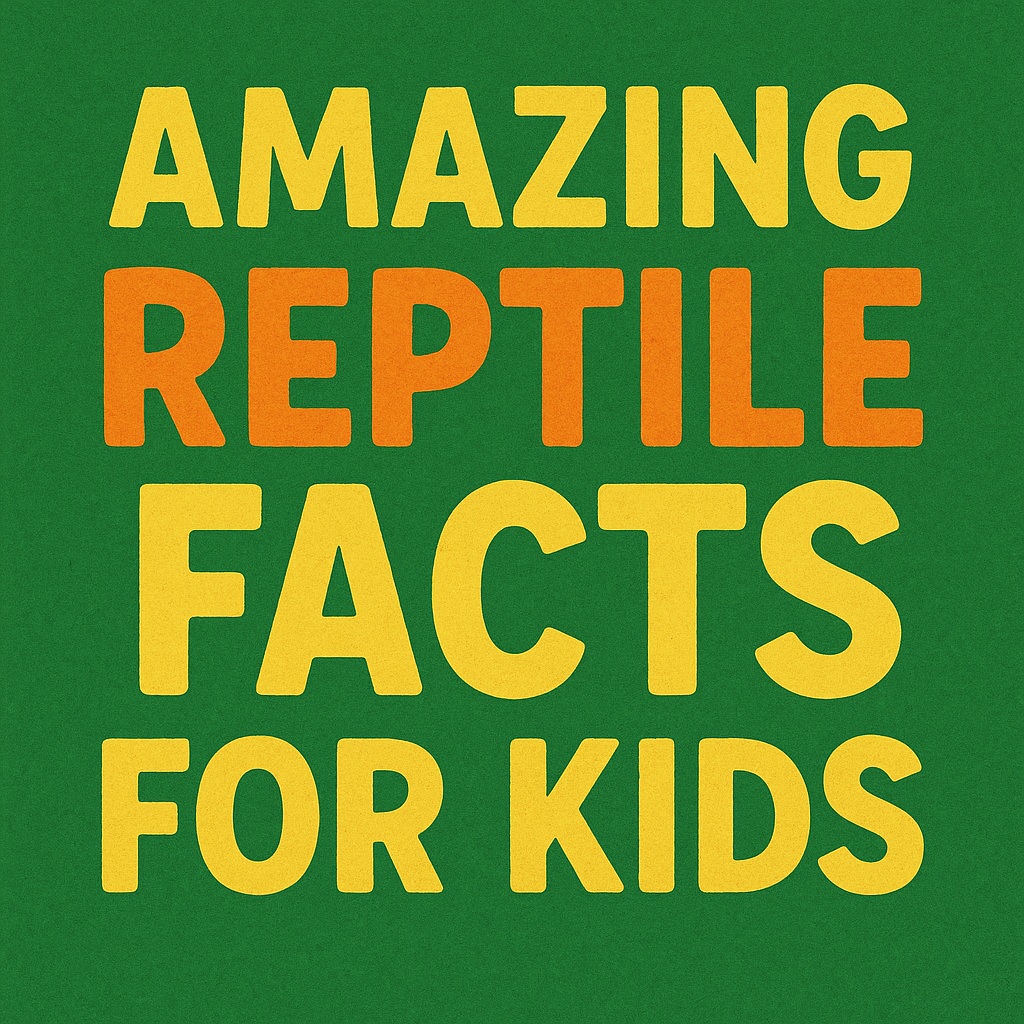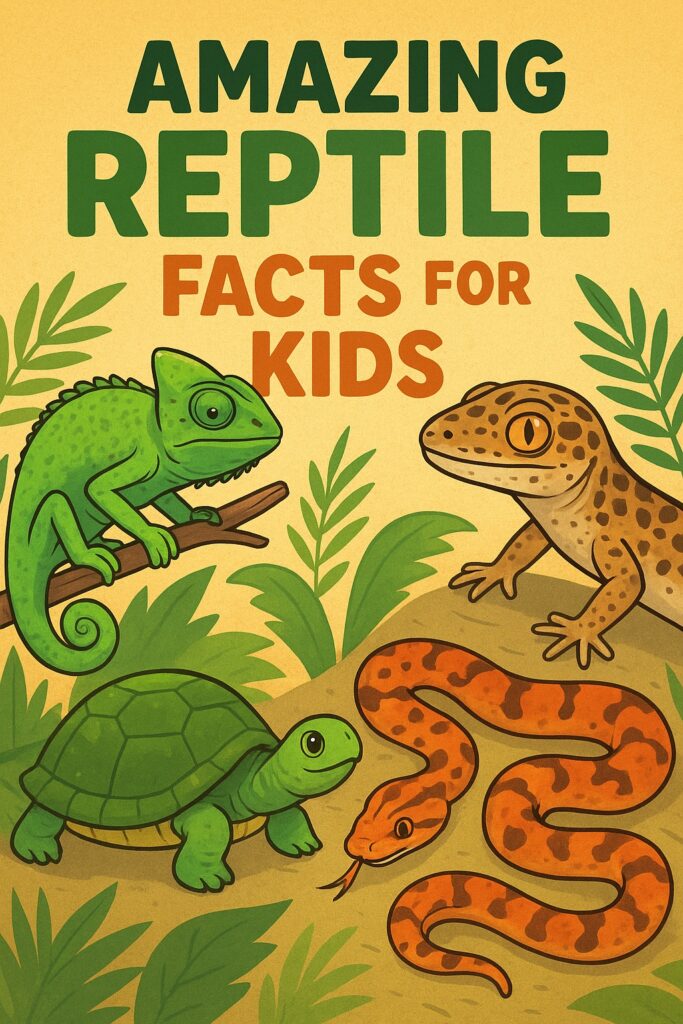
Learn all about lizards, snakes, turtles, and crocodiles — nature’s coolest cold-blooded creatures!
🐢 What Are Reptiles?
Reptiles are cold-blooded animals covered with scales or scutes. They breathe air through lungs and usually lay eggs. The main reptile groups are snakes, lizards, turtles, tortoises, alligators, and crocodiles.
🐍 General Reptile Facts
- Reptiles appeared on Earth over 310 million years ago.
- They are ectothermic, meaning they rely on the environment to control their body temperature.
- Most reptiles lay eggs, but some give live birth!
- There are over 11,000 known species of reptiles worldwide.
- Reptiles can be found on every continent except Antarctica.
- The study of reptiles and amphibians is called herpetology.
- Reptiles have dry, scaly skin that helps prevent water loss.
- They shed their skin regularly as they grow.
- Some reptiles can regrow lost tails, especially lizards.
- Reptiles breathe through lungs only, even if they live in water.
🦎 Lizard Facts
- There are more than 7,000 species of lizards.
- Lizards live in deserts, forests, and even city gardens.
- Some lizards can run on water, like the basilisk lizard — known as the “Jesus Christ Lizard.”
- Geckos have sticky toe pads that let them climb walls and ceilings.
- Chameleons can move their eyes independently in different directions.
- Chameleons change color to communicate and regulate body temperature, not just for camouflage.
- The Komodo dragon is the largest living lizard — up to 10 feet long!
- The smallest lizard is the dwarf gecko, barely half an inch long.
- Lizards use their tongues to sense smells, just like snakes.
- Many lizards perform push-ups to show off or warn other males.
🐍 Snake Facts
- Snakes have no eyelids — they can’t blink!
- They use their forked tongues to pick up scent particles from the air.
- Snakes can dislocate their jaws to swallow prey larger than their heads.
- The reticulated python is the world’s longest snake, reaching over 30 feet.
- The green anaconda is the heaviest snake, weighing up to 550 pounds.
- Some snakes are venomous, using venom to catch prey or defend themselves.
- Others kill by constriction, wrapping around their prey to squeeze.
- The king cobra is the longest venomous snake in the world.
- The Gaboon viper has the longest fangs of any snake — up to 2 inches!
- Snakes shed their skin several times a year.
🐢 Turtle and Tortoise Facts
- Turtles are reptiles with bony shells that protect them.
- Their shells are made of ribs and backbones fused together.
- Turtles live in water, while tortoises live on land.
- Sea turtles can hold their breath for hours underwater.
- Some turtles migrate thousands of miles between feeding and nesting grounds.
- The Galápagos tortoise can live for more than 150 years.
- The leatherback sea turtle is the largest turtle species.
- Turtles don’t have teeth — they use sharp beaks to cut food.
- Baby sea turtles race to the ocean just minutes after hatching.
- Turtles use Earth’s magnetic field to navigate the oceans.
🐊 Crocodile and Alligator Facts
- Crocodiles and alligators are prehistoric reptiles, barely changed for millions of years.
- Crocodiles have a pointed snout, while alligators have a rounded one.
- Crocodiles are usually more aggressive than alligators.
- The saltwater crocodile is the world’s largest reptile, growing over 23 feet long.
- Alligators can live up to 50 years in the wild.
- Crocodiles have the strongest bite force of any animal — over 3,700 psi!
- Their eyes and nostrils sit on top of their heads, so they can see and breathe while underwater.
- Crocodiles cry to remove excess salt from their bodies.
- They care for their eggs and help hatchlings reach water.
- Despite their size, crocodiles are fast swimmers and sprinters.
🐉 Unique and Weird Reptile Facts
- Some reptiles can glide through the air, like the flying dragon lizard.
- The thorny devil lizard drinks water through its skin!
- The horned lizard can shoot blood from its eyes to scare predators.
- The blue-tongued skink sticks out its blue tongue to startle enemies.
- The armadillo girdled lizard curls into a ball for protection.
- The marine iguana is the only sea-going lizard.
- The Gila monster and beaded lizard are venomous lizards.
- Reptiles’ heart rates slow down when they are cold.
- Some snakes can “play dead” for hours to fool predators.
- Many desert reptiles are active only at night to avoid heat.
🌍 Habitat and Adaptation Facts
- Reptiles live in deserts, rainforests, grasslands, and oceans.
- Their scales reduce water loss, perfect for dry climates.
- They bask in the sun to warm up and hide in shade to cool down.
- Reptiles can survive with very little food or water.
- Some turtles hibernate during winter in mud or ponds.
- Crocodiles can slow their heartbeats to conserve oxygen underwater.
- The desert horned lizard’s shape helps it blend with sand.
- Many reptiles use camouflage for hunting or hiding.
- Some tropical reptiles display bright colors to attract mates.
- Island reptiles often evolve into unique species found nowhere else.
🥚 Reproduction and Baby Reptiles
- Most reptiles lay eggs on land.
- Some snakes and lizards give live birth.
- Reptile eggs have leathery shells instead of hard ones.
- Baby reptiles are independent from birth.
- Sea turtles lay up to 100 eggs at once!
- Crocodile mothers guard their nests carefully.
- Temperature determines whether turtle hatchlings are male or female.
- Many reptiles build nests using sand or vegetation.
- Reptile babies grow quickly in their first year.
- Most never meet their fathers — only the mother provides protection.
🧠 Reptile Intelligence & Behavior
- Reptiles are smarter than they seem!
- Some lizards can learn from experience and remember escape routes.
- Crocodiles use tools, such as sticks, to lure birds.
- Sea turtles return to the same beach where they were born.
- Snakes can detect vibrations through the ground.
- Reptiles don’t have emotions like humans, but they can feel stress.
- Some reptiles display territorial behavior.
- Male chameleons show color patterns to impress females.
- Turtles communicate through vibrations and sounds underwater.
- Alligators perform courtship dances with deep bellows.
🌿 Reptiles and the Environment
- Reptiles help control insect and rodent populations.
- They are vital for ecosystem balance.
- Turtles spread seeds through their droppings.
- Snake venom has been used to create life-saving medicines.
- Reptiles face threats from habitat loss and pollution.
- Many species are endangered due to illegal pet trade.
- Conservation programs protect turtles, snakes, and crocodiles worldwide.
- Reptiles are great bioindicators — they reflect environmental health.
- Learning about reptiles helps us understand evolution and adaptation.
- Reptiles may look ancient — but they’re key to Earth’s modern ecosystems!
Facts for Reptile based on their classification:

Lizards (Order: Squamata)
- Some lizards can drop their tail to escape predators, and then grow a new one!
- Lizards have external ear holes, unlike snakes.
- They use their tongues to smell the air like snakes.
- Some lizards change color to blend into their surroundings or show mood.
- They have scales covering their bodies that help protect them.
- The Komodo dragon is the largest living lizard.
- Many lizards can run very fast and climb walls easily.
- Most lizards lay eggs, but some give birth to live young.
- Geckos can stick to smooth surfaces because of tiny hairs on their feet.
- Some desert lizards can survive without drinking water for a long time.
Snakes (Order: Squamata, suborder Serpentes)
- Snakes don’t have legs, but they can move very fast across the ground.
- They “smell” by flicking their forked tongues and picking up scent particles.
- Some snakes are venomous, using venom to catch and digest prey.
- Snakes can swallow animals much bigger than their heads by unhinging their jaws.
- They don’t have eyelids, so they have a clear scale covering their eyes.
- Rattlesnakes warn predators by shaking their tail rattles.
- The world’s longest snake is the reticulated python, which can grow over 30 feet.
- Many snakes shed their skin regularly to grow.
- Some snakes live in trees, while others live underground or in water.
- Sea snakes are adapted to live fully underwater, having special lungs and tail paddles.
Turtles and Tortoises (Order: Testudines)
- Turtles have hard shells made of bones that protect them from predators.
- The shell is their backbone and ribs fused together.
- Sea turtles can hold their breath for several hours underwater.
- Tortoises live mostly on land and can live for over 100 years.
- Some turtles migrate thousands of miles across oceans to lay eggs.
- Baby turtles hatch and head straight to the water on their own.
- All turtles lay eggs on land; sea turtles build nests on beaches.
- The snapping turtle can snap its jaws with great force for defense.
- Painted turtles have colorful markings on their shells.
- Some turtles can breathe through their butts when underwater.
Crocodilians (Order: Crocodilia – Crocodiles, Alligators, Caimans)
- Crocodilians have powerful jaws that can crush almost anything.
- They have eyes and nostrils on top of their heads to see and breathe while mostly submerged.
- Crocodiles can hold their breath under water for up to an hour.
- They are excellent swimmers and can move quickly in water despite their size.
- Alligators have a wider snout compared to crocodiles.
- Some species build huge nests and guard their eggs fiercely.
- Baby crocodilians make noises to alert their mother when ready to hatch.
- Crocodiles have a four-chambered heart, more efficient than most reptiles.
- They use their tails to propel themselves in water and for defense.
- Crocodilians are some of the closest living relatives to dinosaurs.
Tuataras (Order: Rhynchocephalia)
- Tuataras look like lizards but belong to a completely different reptile order.
- They are native only to New Zealand and are called “living fossils.”
- Tuataras have a third “parietal eye” on the top of their head that senses light changes.
- They are mostly nocturnal and live in burrows.
- Tuataras can live for over 100 years in the wild.
- Their teeth are unique and fused to their jawbone, unlike other reptiles.
- Tuataras hatch after a very long incubation period—up to 15 months!
- They feed mostly on insects, small birds, and eggs.
- Despite their age, tuataras have a slow growth rate and late maturity.
- Conservation efforts are underway to protect these rare reptiles from predators.
🌎 Why Reptiles Are Awesome
Reptiles are some of the most diverse and fascinating creatures on the planet. From tiny geckos to giant crocodiles, they show incredible ways life adapts to survive. Whether you find them cute, cool, or creepy — reptiles truly deserve our respect and protection.
